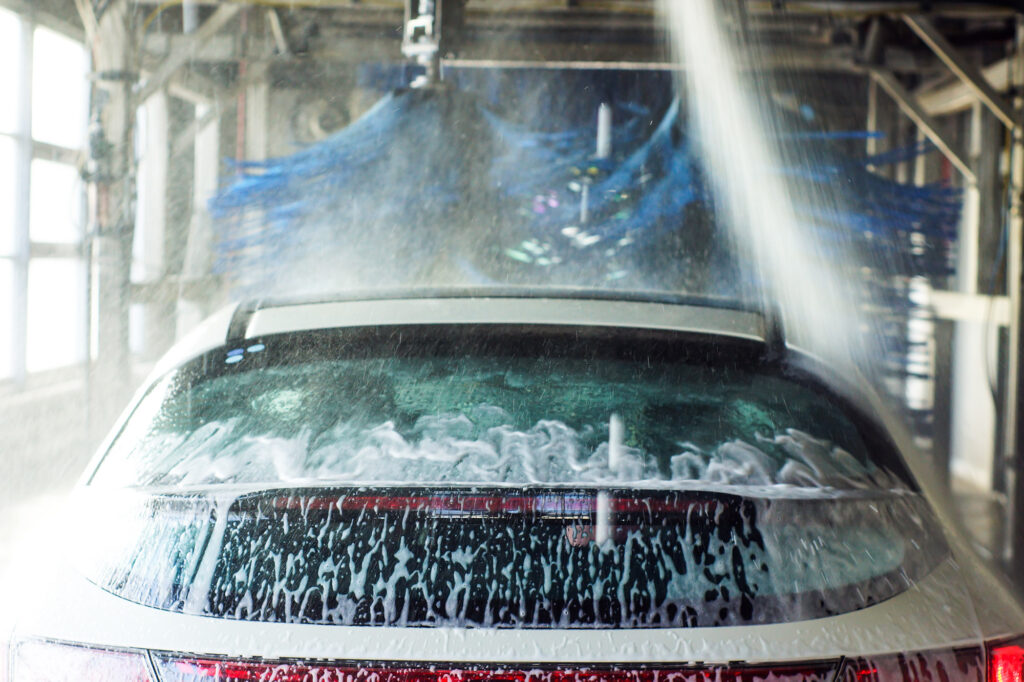When it comes to cleaning your vehicle quickly and effectively, brushless car washes are hard to beat. What sets them apart from other car washes is how foam fingers and cloth strips substitute brushes, scrubbing your vehicle clean without scratching it.
Brushless car washes are popular with many drivers, but are they really all that? Here are some of their many benefits and drawbacks.
Brushless Car Wash Pros
Using a brushless automatic car wash comes with a lot of advantages, many of which don’t come with more traditional car washing methods.
Better for the Environment

Mandated by law, brushless car washes must have water reclamation systems. This means these facilities only use recycled water.
Make no mistake — this doesn’t mean that the water is dirty. Recycled water is filtered, cleaned, and treated to remove chemicals and impurities.
The use of recycled water minimizes waste, making brushless car washes better for the environment than other forms of car washes.
Easier on the Wallet
Because brushless car washes require less manual labor than hiring someone to clean your vehicle by hand, it’s also a lot cheaper. Expect a complete brushless car wash for roughly $20.
Faster Than Most Methods
Though hand washing is undoubtedly more thorough and better at cleaning the harder-to-reach places, it’s hard to beat brushless car washes when it comes to speed.
Just because brushless car washing isn’t as thorough doesn’t make it any less effective. When it comes to scrubbing dirt off a larger area relative to how much time you spend at the car wash, you can’t go wrong with brushless car washes.
Doesn’t Damage the Vehicle
Brushes used in automatic car washes tend to cause scrapes and scratches. On the other hand, foam fingers and cloth strips are far less likely to do so because they’re soft and not abrasive.
Plus, brushless car washes are also perfect for winter because washing cars by hand becomes harder to do in low temperatures. After all, if your vehicle doesn’t dry properly, it could become susceptible to damage. The excess water and any lingering dirt could freeze and damage or stain the coat.
Brushless Car Wash Cons
Though brushless car washes come with a lot of advantages, there’s no denying that it isn’t a perfect cleaning method. Here are some of their cons.
Doesn’t Clean Your Vehicle Completely
Because brushless car washes only clean the accessible parts of your vehicle, they can’t wash parts that are harder to reach such as seams and nooks. Cloth strips and foam fingers can only reach so far.
At some point, you’ll need to take matters into your own hands and scrub your vehicle with a brush to prevent dirt from building up in those harder-to-reach crannies.
Drying Methods Aren’t as Effective
Brushless car washes typically dry your vehicle with high-power blowers, blasting your car with air until all the soap, water, and other cleaning solutions have dried up.
While this gets the job done well, it takes a lot longer than wiping your vehicle with a towel. It could leave streaks and watermarks, giving way to ugly surface-level stains on the coat. Even using the windshield wipers can cause windshield stains after air drying the vehicle.
Excessive Chemical Use
Because they can’t use brushes to clean your vehicle thoroughly, these facilities compensate by using harsher cleaning solutions loaded with chemicals capable of dissolving dirt.
Unfortunately, strong chemicals can also ruin the coat of your vehicle, damaging its finish and its shine.
Risk of Scratches
Unfortunately, if the foam fingers and cloth strips used to scrub your vehicle aren’t properly cleaned and maintained, they might accidentally scratch the surface of your vehicle.
The odds of your vehicle getting scratched increase exponentially if there’s already existing damage in the paint coating. This happens when solid clumps of dirt and other debris get stuck on the cloth strips and foam fingers, which then scrape against your car.

Frequently Asked Questions
What’s the difference between a brushless car wash and a touchless car wash?
Brushless car washes use foam fingers or cloth strips, water, and cleaning solutions to clean vehicles.
On the other hand, touchless car washes don’t use brushes, foam fingers, or any form of cleaning that requires a material surface to make contact with your vehicle.
Instead, they use high-pressure hoses to spray your vehicle with water and chemicals, cleaning your vehicle without “touching” it.
Can you perform a brushless car wash with pickup trucks?
Yes, it’s perfectly safe to do a brushless car wash on larger vehicles like pickup trucks. Even the exposed pickup bed can be cleaned safely. Just make sure it’s empty before starting.
Depending on where you get a brushless car wash, you might need to fold or remove side mirrors as they might get damaged or bent during the process. Similarly, raised suspension systems and oversized wheels might make a pickup truck too large for the wash.
Can brushless car washes damage your vehicle’s paint?
Brushless car washes generally don’t damage the paint of vehicles. However, if a vehicle already has existing paint damage, there’s a slim chance that brushless car washes can expand them. Seemingly small damage like peeling or chipping paint can spread and become larger.
Damage such as paint abrasions and chipped coating might increase, so your vehicle must be in good condition before going through the wash. Newly painted cars are also safe in brushless car washes as long as the paint has ample time to cure.
If ever you had your car repainted recently, consult the body shop that applied the coat to learn how long you’ll have to wait. On average, repainted cars take at least 30 days to finish curing.
Any information provided on this Website is for informational purposes only and is not intended to replace consultation with a professional mechanic. The accuracy and timeliness of the information may change from the time of publication.















